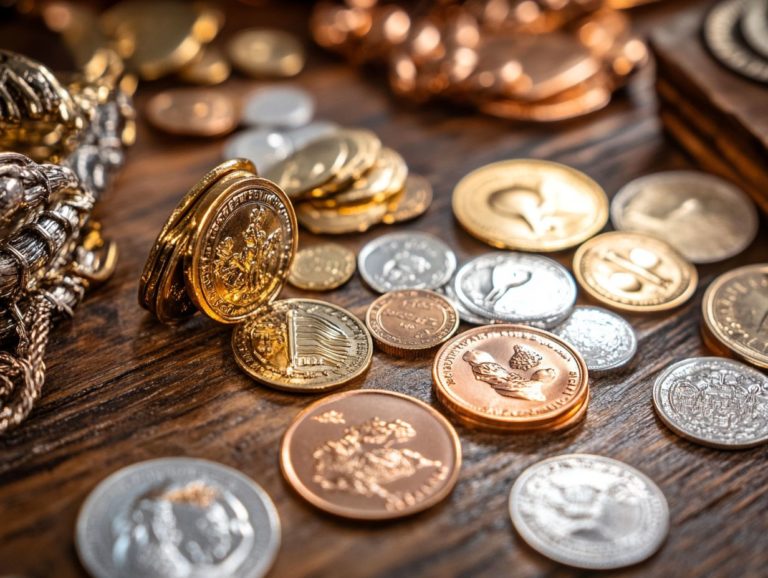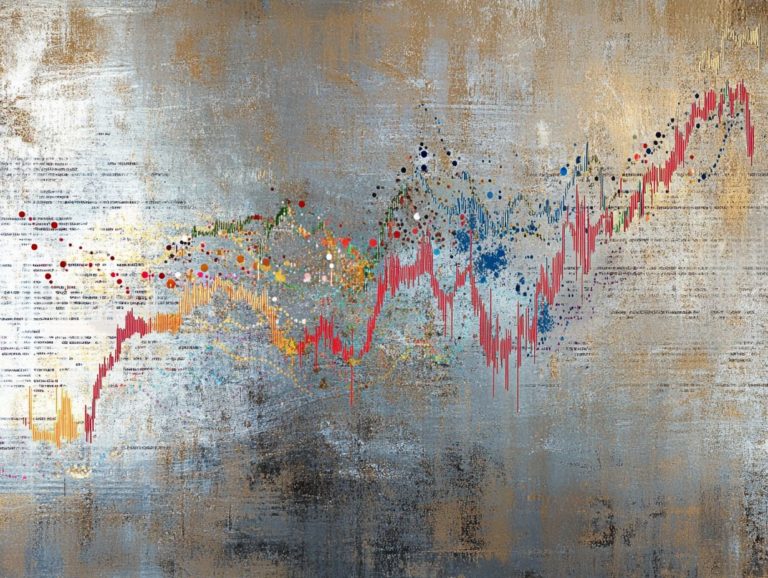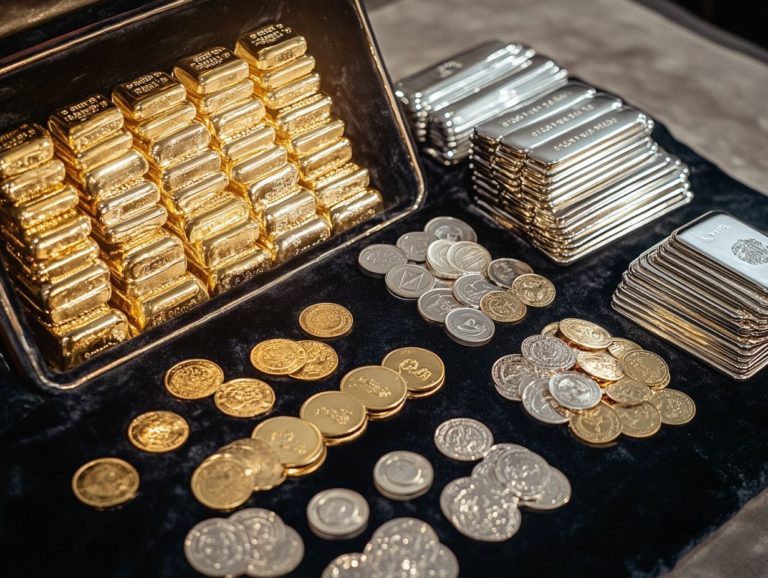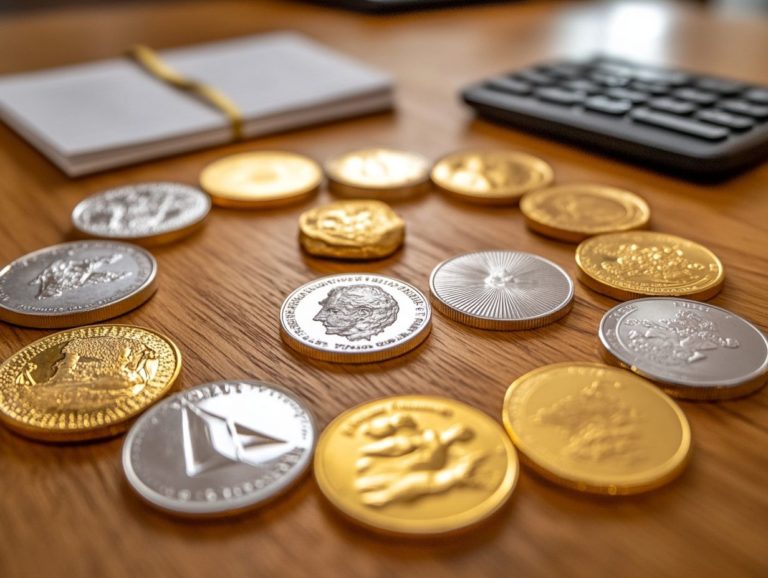What are the Pros and Cons of Investing in Palladium?
Palladium is an enticing investment opportunity, captivating both novice and seasoned investors alike. Its unique role in the precious metals market makes it essential to understand palladium, especially its strong demand, limited supply, and factors that influence its price.
As with any investment, there are risks and ethical considerations to navigate. This article explores the pros and cons of investing in palladium, equipping you with insights to make informed decisions that align with your financial goals.
Contents
Key Takeaways:
- Palladium is a rare and valuable precious metal with high demand and limited supply.
- Investing in palladium can diversify your portfolio but also carries risks and ethical considerations.
- Conduct market analysis and consider personal goals before investing in palladium.
Understanding Palladium as an Investment
Understanding palladium as an investment involves exploring its distinct characteristics and market dynamics. This metal is notable for its purity and beauty and significant industrial applications, especially in automotive technology and in devices called catalytic converters that reduce vehicle emissions.
As global demand rises amid supply shortages, it presents a golden opportunity to diversify your portfolio, particularly during economic uncertainties and price fluctuations.
What is Palladium?
Palladium is a rare precious metal from the platinum group, known for its high purity and abilities as a chemical catalyst. Its chemical symbol is Pd, and it has an atomic number of 46. Discovered in 1803 by British chemist William Hyde Wollaston, palladium has excellent corrosion resistance and can absorb hydrogen.
This metal is crucial in various industries, especially in catalytic converters that help reduce harmful emissions from vehicles. Palladium is also essential in hydrogen purification processes, highlighting its importance in modern technology and sustainability.
Market Trends and Performance
The palladium market is characterized by significant fluctuations due to historical price trends, market demand, and supply shortages. Recent data shows price movements shaped by economic factors, like geopolitical tensions and evolving emissions regulations that boost demand for palladium.
Watch trends from major producers like South Africa and Russia, where disruptions have intensified supply constraints. These challenges highlight the need to monitor forecasted prices and adjust expectations according to inventories and mining activity.
Pros of Investing in Palladium
Investing in palladium offers compelling advantages due to its high demand and limited supply. This combination makes it an attractive choice for portfolio diversification.
High Demand and Limited Supply
The soaring demand for palladium in automotive technology, particularly in catalytic converters, contrasts sharply with its limited supply. Stricter emissions regulations drive this demand as vehicles require more efficient converters.
With the growth of the electric vehicle market, interest in hybrid models that rely on palladium components also rises. Geopolitical tensions in producing nations tighten supply, enhancing palladium’s appeal to investors seeking stability amid market volatility.
Diversification and Growth Potential
Palladium offers a unique avenue for diversification during periods of economic uncertainty. Incorporating it into your portfolio can safeguard assets and optimize potential returns.
Unlike stocks or bonds, palladium has shown remarkable growth potential due to its critical industrial applications. Investing in alternative assets reduces risk and enhances overall portfolio performance.
Cons of Investing in Palladium
Investing in palladium has benefits but also notable drawbacks. It’s essential to consider these aspects before investing.
Volatility and Risk Factors
Palladium prices can be volatile, influenced by fluctuating demand in the automotive industry and supply chain disruptions. Geopolitical events can amplify these price changes, making it crucial to stay informed.
Managing these risks through a diversified portfolio and employing hedging strategies can help secure a more stable investment outcome.
Environmental and Ethical Concerns
Palladium mining practices raise environmental and ethical concerns that can impact demand and investment appeal. Mining often leads to ecological disruption, including habitat destruction and water contamination.
Labor practices in mining regions raise ethical questions about worker exploitation. Stakeholders increasingly emphasize ethical sourcing and environmental responsibility, which influence market dynamics.
Factors to Consider Before Investing in Palladium
Before investing in palladium, consider these factors:
- Conduct thorough market analysis
- Define your personal investment goals
- Seek expert insights regarding future performance
Market Analysis and Personal Goals
Conducting market analysis and understanding your investment goals is crucial for developing an effective palladium investment strategy. Pay attention to economic indicators and geopolitical events to uncover insights into market trends.
Aligning your strategies with market conditions enhances your portfolio’s resilience and helps you seize opportunities for long-term growth.
Expert Opinions and Strategies
Consulting expert opinions on the palladium market can enhance your investment decision-making. Professionals offer insights into price movements and emphasize the importance of timing your purchases.
Diversifying investments—through ETFs, equities, or direct investments—provides a layered approach to managing risk. Staying informed positions you advantageously in an ever-evolving marketplace.
Frequently Asked Questions
What are the Pros of Investing in Palladium?
- High demand: Essential in industries like automotive and electronics.
- Limited supply: Its rarity creates potential for price appreciation.
- Diversification: Helps reduce overall risk in your portfolio.
- Inflation hedge: Historically serves as a strong hedge during inflation.
- Potential for high returns: Offers significant returns during economic growth.
What are the Cons of Investing in Palladium?
- Volatility: Prices fluctuate significantly.
- High barriers to entry: Requires substantial capital investment.
- Limited liquidity: Harder to sell than other precious metals.
- Environmental concerns: Mining practices raise red flags for socially responsible investors.
- Reliance on industrial demand: Value heavily depends on industrial uses, which can be unpredictable.



.jpg_00.jpeg)


.jpg_01.jpeg)

.jpg_10.jpeg)


.jpg_11.jpeg)





